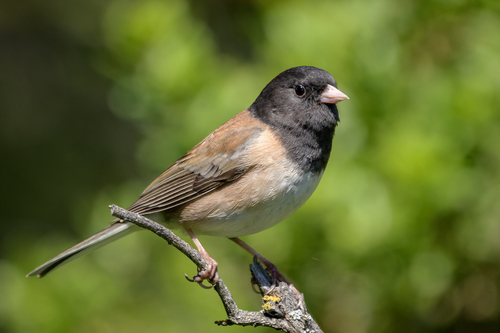
Dark-eyed Junco
The Dark-eyed Junco (Junco hyemalis) is a widespread and highly variable species of sparrow found across North America. Known for their adaptability, juncos occupy a wide range of habitats, from boreal forests to suburban backyards. They play a significant ecological role as seed dispersers and a food source for predators. While not culturally prominent in the same way as some birds, they are familiar and well-loved by birdwatchers, often referred to as 'snowbirds' due to their increased visibility in many areas during winter.
13-17.5 cm
Length
18-25 cm
Wingspan
Least Concern
Conservation Status
Distribution
Breeds across much of North America, from Alaska and Canada south to the mountains of Mexico and parts of the southern United States. Many populations are migratory, wintering in the central and southern US and Mexico. Altitudinal range varies from sea level to over 3,000 meters.
Lifespan
Average lifespan in the wild is not well-documented, but likely 3-7 years. Maximum recorded lifespan in the wild is over 11 years.
Dark-eyed Junco's Habitat
Habitat Types
Coniferous forests, Mixed woodlands, Open woodlands, Brushy areas, Parks, Gardens
Climate Zones
Boreal, Temperate, Subtropical (at higher elevations)
Adaptations
Highly adaptable to a variety of habitats; able to tolerate cold temperatures and utilize a wide range of food sources. Some populations show adaptations to specific altitudes, such as larger body size in colder, higher-elevation environments.
Variations
Multiple subspecies exist, with significant variation in plumage color and pattern. Major groups include the 'Slate-colored Junco', 'Oregon Junco', 'Pink-sided Junco', 'White-winged Junco', and 'Gray-headed Junco'.
Appearance
Breeding Plumage
Plumage generally does not change significantly between breeding and non-breeding seasons, although colors may be slightly brighter during breeding.
Seasonal Feather Changes
Minimal seasonal variation, some wear may make plumage look duller.
Sex Based Plumage Differences
Males often have darker, more contrasting plumage than females, particularly on the head and back. Females tend to be browner or grayer.
Notable Features
Dark eyes (in most subspecies), Pink bill, White outer tail feathers (conspicuous in flight), Variable plumage color and pattern depending on subspecies
Diet and Feeding
Primary Foods
Seeds, Insects, Small fruits, Berries
Foraging Behavior
Primarily forages on the ground, hopping and scratching to uncover seeds and insects. Often feeds in flocks, especially during winter.
Specializations
No highly specialized feeding adaptations; generalist diet contributes to adaptability.
Seasonal Diet Variations
Diet shifts seasonally, with insects and other invertebrates being more important during the breeding season, while seeds make up the bulk of the diet in winter.
Behavior
Social Structure
Forms flocks outside of the breeding season, sometimes with other sparrow species. During breeding, pairs are territorial.
Communication
Simple, high-pitched trill song, Various call notes, including 'chip' and 'tseet' sounds, Flashing white outer tail feathers (visual signal)
Migration
Many populations are migratory, traveling south for the winter. Migration distances vary; some populations are resident year-round.
Territorial or Group Behaviors
Males defend territories during the breeding season. In winter, flocks establish dominance hierarchies at feeding sites.
Conservation
Threats
Habitat loss and degradation, Climate change (potential impacts on breeding habitat and food availability), Collisions with windows and other structures, Predation by cats
Protection Programs
No specific, large-scale protection programs are currently in place, but juncos benefit from general habitat conservation efforts.
Local National Laws
Protected under the Migratory Bird Treaty Act in the United States.
Population Trend
Stable
Population Estimates
Global population estimated at around 630 million individuals.
Interesting Facts
Dark-eyed Juncos show remarkable variation in plumage across their range.
This has led to the recognition of multiple subspecies, and ongoing debate about species limits.
They are one of the most common birds at backyard feeders in North America during winter.
Their willingness to visit feeders makes them easy to observe.
Juncos often flash their white outer tail feathers in flight, which may serve as a warning signal to other birds.
This behavior is also used in courtship displays.
In some regions, they're known as "snowbirds."
Because their arrival often coincides with the first snowfall of the season.
Faqs about Dark-eyed Junco
What do Dark-eyed Juncos eat?
They eat mainly seeds and insects, with the proportions changing seasonally. In winter, they rely heavily on seeds, while in summer, they consume more insects.
Where do Dark-eyed Juncos nest?
They typically build their cup-shaped nests on the ground, often hidden under vegetation, rocks, or tree roots.
Are Dark-eyed Juncos migratory?
Many populations are migratory, moving south for the winter. However, some populations are resident year-round, especially in milder climates.
Why are there so many different color variations of Dark-eyed Juncos?
The different color variations represent different subspecies, which have evolved in different geographic regions.
How can I attract Dark-eyed Juncos to my yard?
Provide a source of seeds, such as a platform or ground feeder, especially during the winter. They also appreciate a source of water.
Copyright @ Nature Style Limited. All Rights Reserved.
 English
English